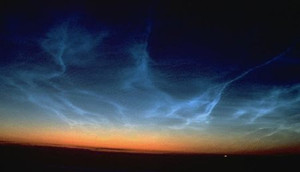Middle Atmosphere Processes and Lifetime Evaluations (MAPLE)
Middle/Upper Atmosphere – Past Projects
Funded by NERC project from May 2012-May 2014
People: Martyn Chipperfield (PI, SEE), John Plane (CO-I, Chemistry), Piers Forster (SEE), Sandip Dhomse (SEE), Alex Rap (SEE), Tamas Kovacs (Chemistry), Anna Totterdil(Chemistry) and Wuhu Feng (NCAS, Chemistry).

Image credit: Pekka Parviainen
Ozone-depleting substances (ODS), such as chlorofluorocarbons (CFCs), are long-lived source gases which decompose in the stratosphere to release chlorine and bromine. Under the Montreal Protocol the emissions of these species have been phased out, but the rate of recovery of the ozone layer will depend on the atmospheric lifetime of the these gases and their replacements which are still being emitted. In fact, there is currently significant uncertainty in these atmospheric lifetimes, which are used in all model predictions of future halogen loadings (via predicted surface mixing ratio model boundary conditions). This key uncertainty has been recognised by the recent establishment of a WCRP/SPARC project to re-evaluate the lifetimes of these ODSs and their replacements (such as hydrofluorocarbons, HFCs) using up-to-date laboratory data in state-of-the-art 3-D chemistry-climate models (CCMs). These species are also efficient greenhouse gases (GHGs) and changes to their known atmospheric lifetime will change estimates of their global warming/temperature potential (GWP/GTP).
Previous model studies of the recovery of the ozone layer have used predicted future surface ODS mixing ratios based on old lifetime estimates and a simple box model. Therefore, the major driver of future ozone change, the stratospheric chlorine and bromine loading, has been constrained with crude time-dependent boundary conditions. A more realistic representation of the rate of ozone recovery can be obtained by removing this constraint and running the CCMs such as UKCA with emission flux boundary conditions for major ODSs, and allow the model itself to predict the future decadal removal of chlorine and bromine.
Source gases with very long lifetimes (many hundreds to thousands of years) are too stable to affect stratospheric ozone by decomposition but they are invariably potent GHGs. For these gases mesospheric loss processes, which are usually ignored or treated very crudely, could significantly reduce their atmospheric lifetime, thereby decreasing their estimated climate impact. Three examples of such gases are NF3, CF3CF2Cl (CFC-115) and SF6, with current WMO lifetime estimates of 500, 1020 and 3200 years, respectively. We have identified that the reactions of these gases with metallic atoms (Fe, Na and Mg) in the upper mesosphere could be an important additional sink and compete with Lyman-α photolysis and electron attachment (in the case of SF6). The rates of these sinks need to be evaluated in the laboratory and the impact on lifetime and GWP/GTP needs to be calculated.
This 2-year project will therefore study the following key questions:
- What are the current best estimates of atmospheric lifetimes and GWPs for major ODSs and replacements as diagnosed by a state-of-the-art 3-D CCM?
- What is the timescale for recovery of the ozone layer in a free-running climate model with a more realistic description of halocarbon removal processes?
- For very long-lived gases (τ > 300 years) can efficient mesospheric sinks decrease their lifetime, and hence GWP/GTP?
Given these questions, our specific science objectives are to: - Participate in the imminent SPARC Lifetime Re-evaluation by providing full, coordinated UKCA simulations and by leading the model analysis to quantify the lifetimes of major ODSs and replacements.
- Perform 21st century simulations of the UK CCM (UKCA) with flux boundary conditions to provide new more accurate estimates of the rate of recovery of the O3 layer as ODSs decline.
- Study the removal of NF3, CFC-115 and SF6 in the upper mesosphere through reaction with metal atoms and Lyman-α photolysis.
- Implement these mesospheric loss processes, together with plasma-driven loss processes, in the whole atmosphere model WACCM and assess their impact on lifetimes.
- Assess GWP and GTP for the major ODSs, HFCs, SF6, NF3 using our new lifetime estimates and model concentration distributions.
Our contributions: We use WACCM to evaluate the role of dynamical transport and chemistry in the stratosphere-mesosphere-thermosphere in determining the atmospheric lifetimes of NF3, SF6 and CFC-115. To provide new best estimates of the lifetimes of these species using a detailed, state-of-the-art middle atmosphere model. To develop tabulated upper atmosphere loss rates for these species for use in UKCA. - Methodology
The following loss processes will be added to WACCM, by combining the results from WP3 with data from the literature: Photodissociation at Lyman-α, and at wavelengths longer than 180 nm for NF3 [Dillon et al, 2010]; reaction with Fe, Na and Mg atoms; the reaction of O(1D) with NF3 [Dillon et al, 2010]; electron attachment to SF6, and reaction with O+ [Morris et al, 1995]. These processes will be straightforward to input to WACCM using its chemical pre-processor with the help of Dr Wuhu Feng (University of Leeds, fully funded on NERC grant for duration of project). We will perform two present-day timeslice runs (~30 years), with constant surface mixing ratio boundary conditions, with and without these new loss processes. Tracer loss rates for different processes will stored and used to estimate the atmospheric lifetime of these species when the run has equilibrated (mean burden / annual loss). The overall loss rate for SF6 derived from WACCM will be tabulated and added into to UKCA which, like other CCMs, uses SF6 as a tracer for diagnosing age-of-air. The parameterised SF6 tracer in UKCA will be compared with SF6 in WACCM and with MIPAS satellite observations [Reddmann et al., 2001]
